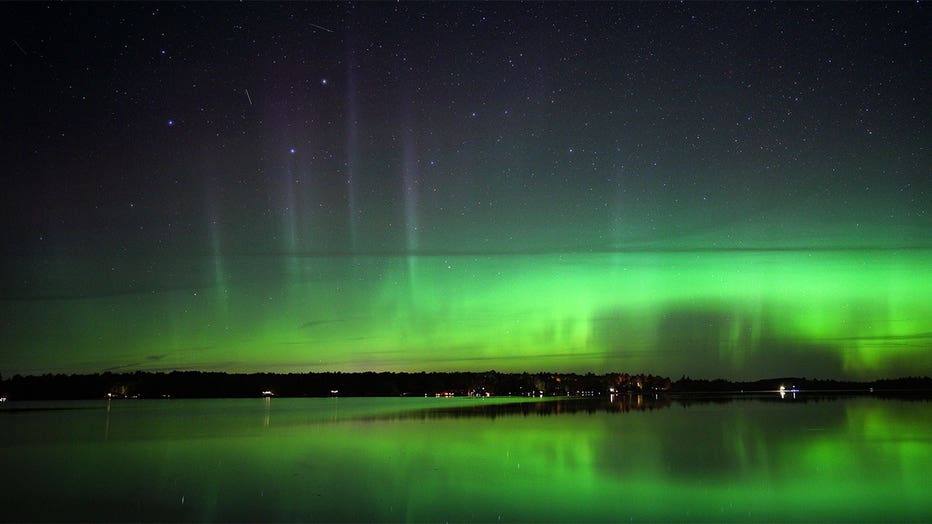Northern Lights in MN could be very active on Friday due to 'severe' storm

MN weather: Northern Lights possible Friday night
After some clouds and potential rain Friday afternoon, the sky is expected clear, which should lead to pretty decent conditions for any Northern Lights viewing on Friday night and early Saturday morning.
MINNEAPOLIS (FOX 9) - A "severe solar storm" could set the stage for a brilliant Northern Lights display in Minnesota and much of the United States on Friday night.
The National Oceanic and Atmospheric Administration (NOAA) is forecasting a G4 (severe) geomagnetic storm from late Friday into early Saturday morning. For reference, a G5 is the highest level on the storm scale. This geomagnetic storm is being fueled by several coronal mass ejections or CMEs from the sun that are expected to merge before hitting the Earth's atmosphere.
This is the first G4 watch that has been issued since 2005, NOAA said in a call with the media on Friday.
RELATED: Solar flare could disrupt communications, produce northern lights
Aurora could be visible in Minnesota and beyond
The National Weather Service for the Twin Cities calls the solar activity "one of the strongest solar storms we've seen in a decade." The potential is there for a very active aurora in Minnesota and Wisconsin, NWS notes. Meanwhile, NOAA says "The aurora may become visible over much of the northern half of the country, and maybe as far south as Alabama to northern California."
What could make this event different from past Northern Lights forecasts is that this has the potential to be the strongest solar storm to hit Earth in roughly 20 years. The stronger the storm, the higher the probability of getting to experience a far more visible view of the Aurora here in Minnesota. So that could mean seeing the lights higher above the horizon and actually seeing some of the nuisances that come with the dancing aurora that is commonplace in Canada, but often invisible to us here in Minnesota, especially south of Lake Superior.
Right now, the weather forecast is calling for some afternoon and evening clouds and isolated storms, but the sky will clear quickly Friday evening, leading to likely clear conditions for any potential viewing, putting Minnesotans in prime seats for seeing the Northern Lights.
As always, it's important to know the aurora is tricky to forecast and nothing is guaranteed.

Northern lights are seen in the night sky near Canyon, Minnesota on Friday, August 30, 2019. (Brian Peterson/Star Tribune / Getty Images)
Sunspots visible from Earth
The coronal mass ejections or CMEs originate from sunspots which are cooler locations on the sun itself. The sunspot that produced these CMEs is one of the largest in years and is big enough to see from the surface of the earth.
However, you obviously wouldn't want to stare at the sun but since many of us may still have solar eclipse glasses you can repurpose those and look through them to see a sunspot on the sun.
Have we had more auroras recently?
For those keeping track, it may seem like we have had far more chances to view the Northern Lights in recent years, and they have seemingly been seen much farther south than in the past. Has something changed? The answer is both, yes and no.
- Just like a weather forecast inside our atmosphere, space weather forecasts have improved drastically over the last couple of decades, so we can detect more of these potential events ahead of time.
- With constantly improving technology, we can now "see" the aurora on a much larger scale. This allows your high-quality camera, and most newer smartphones for that matter, to be able to see the subtle nature of the aurora much farther south than the naked eye can. This is why you can find the "auroral glow" photos from many different events in places far south such as the Carolinas, Oklahoma and California in recent years. However, in many or all of these cases, the camera can see it, but your eyes cannot.
- The sun goes through many different cycles, both short-term and long-term. One of those cycles includes sunspots, the areas of the sun that produce solar flares leading to auroras here on Earth. These cycles are six years long going from a maximum to a minimum amount of sunspots during that period. That's why there appear to be far more Northern Light events that happen in some years than in others — because the sun is in a different part of the sunspot cycle. The last couple of sunspot maximums, the point in the cycle that had the most sunspots, were actually some of the quietest observed dating back to the mid-20th century. That means that the 2010s and early 2020s experienced some of the fewest sunspots on record and therefore, we had very few auroral events when comparing them to the previous few decades.
Tips for viewing the aurora
As always, you should get away from population centers for the best chance of seeing the aurora. Light pollution from cities makes it difficult to see stars and the aurora.
Also, the further north you can go, the better shot you will have to see the lights.
The moon can also impact our chances of seeing the aurora. Luckily, we are in a new moon phase this weekend.
Typically, the best viewing times for the aurora are within an hour or two of midnight.


